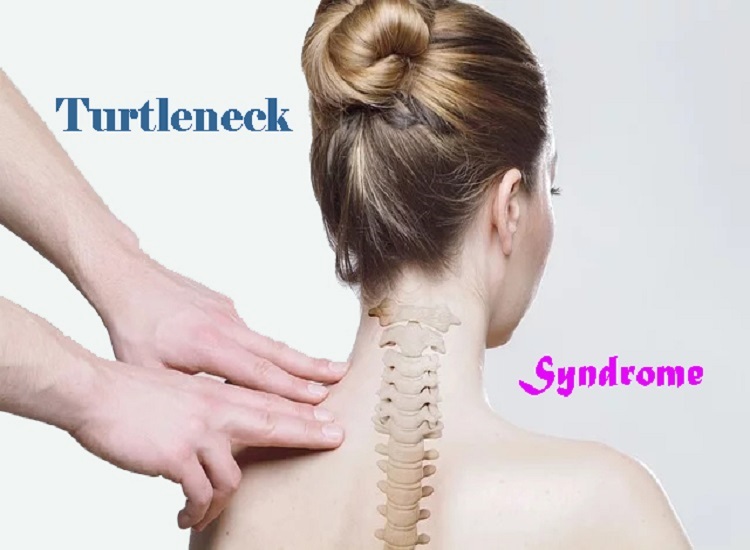Turtleneck Syndrome is not actually a medical term to be precise. However, the “Turtleneck syndrome” slang has been used for improper posture where your neck is jutting out to look at the electronic gadget in your hand. Now – hopefully – you understand what we are talking about. Perhaps, you are exactly in the same pose while reading this article!
What is Turtleneck Syndrome?
Turtleneck syndrome refers to the collection of symptoms that are caused by improper posture where your head is jutting out while using electronic gadgets like smartphones, tablets, laptops, etc.
Your posture when using the gadgets is never ideal. This includes several inappropriate poses which include
- You are looking down continually
- Your shoulders are slumped towards the front
- Your head is stuck too forward and out.
Since your neck and head are too far away towards the front of your body, this posture can result in neck and shoulder-related health conditions. It can sometimes result in headaches as well. The symptoms associated with all these improper poses are collectively called turtle neck syndrome.
Another popular turtleneck slang is text neck syndrome. It is also called tech neck. This is a common condition that affects millions of people who tend to stay glued to their electronic gadgets – be it smartphones, tablets, laptops, or even PCs.
Symptoms of Turtle Neck Syndrome
In fact, Turtle neck syndrome is not a well-defined medical condition. This is evident when searching for the Turtleneck Syndrome Urban Dictionary definition. You will typically find no definition that you expect (Maybe the new definition will come up in a couple of years).
That would mean you may or may not find the typical symptoms as in the case of other diseases and conditions when it comes to Turtleneck syndrome. Any symptom that has a relation to the improper pose of using a gadget constitutes a symptom of the syndrome.
Stiffness
Stiffness is a widely prevalent symptom of turtleneck syndrome. This can result due to the prolonged forward bend of your head. This will lead to muscle tension and reduced flexibility in the neck. You will also feel a lot of difficulty in moving your head or neck freely. There is a continued sensation of tightness and discomfort.
Pain
This is another common symptom of turtleneck syndrome. This pain typically arises due to prolonged use of the screen. It can also be due to the poor posture while using the gadgets. This sort of pain may also be associated with headaches. It can affect your overall comfortability and can also restrict your daily activities.
Weakness in the muscle
The turtleneck syndrome can result in muscular weakness. This is primarily due to the strain on the neck muscles. You may feel lower strength and endurance throughout the day. Continuous wrong posture can result in reduced muscle functionality. This would ultimately contribute to discomfort and limited mobility. This can indicate a severe turtleneck syndrome.
How to prevent Turtleneck syndrome?
Well, if you have gone through what causes the turtleneck syndrome, you should be aware of how to prevent it. But, yes. The syndrome is highly preventable and can be managed effectively by following the appropriate and effective techniques.
- Take care of your posture – Take absolute care of your posture. Especially, when using electronic gadgets. Keep your neck neutral and spine straight. This will automatically keep you in the proper posture.
- Take breaks – When using electronic gadgets, make sure to take enough breaks. Set timers for shorter breaks of 20 to 30 minutes. When you are taking these breaks, make sure to stand up, stretch your neck, and stretch your shoulders. Also, make sure to look away from the screen.
- Focus on ergonomics – Always keep your devices at your eye level. It may also be a good idea to invest in a laptop stand or phone stand to help you elevate the height of your screen.
- Strengthen your core – One of the best options to take care of your posture is to have strong core muscles. Including core exercises such as planks and bridges in your regime is a good idea.
Can turtle neck be corrected?

Yes, definitely. Turtleneck syndrome is a posture-related issue and not an illness. You can get rid of the issues by developing a good posture habit or undertaking regular exercises. Having a good [postural awareness and being ready to change habits can go a long way in correcting the issues related to the turtleneck syndrome.
It may be a good idea to apply some good exercises to help you achieve this goal. There are a few good exercises and stretches that can help you in taking care of your neck and head. These stretches can help fight tightness and improve your mobility.
- Chin Tucks – Slowly tucking your chin towards your chest can help you take care of the sensitivity. Repeat this exercise ten times.
- Side bends – Tilt your ears to your shoulder. Hold for around 10 seconds and then repeat the steps on the other side. Repeat this five times.
- Rotations – Rotate your head gradually in a semi-circular motion. Make ten repetitions on each side.
Remember that you need to be consistent with these exercises. If you make these your daily routine, it can help you in combating the turtleneck syndrome effectively. You can undertake a tech-savvy life with no need to worry about developing of this.
Do note that these are just a few suggestions for the best exercises to handle your turtleneck syndrome issues. You can consult your health service provider for more proactive measures.
Conclusion
You can not avoid tech gadgets today. So, that would mean we cannot avoid the extensive use of modern gadgets like smartphones and tablets. But, you can definitely avoid the possibility of developing the issues like turtleneck syndrome. It would ideally require a multifaceted approach, but definitely something that can be done.
FAQs:
A: The symptoms of the Turtleneck syndrome include neck stiffness, pain (sometimes with headaches), and weakness in the neck muscles. You may also feel tightness and discomfort.
A: You can address the Turtleneck syndrome through a postural correction and changing your habits. Neck and head stretches should be yet another means to address it.
Read More:





